ISSN ONLINE(2319-8753)PRINT(2347-6710)
ISSN ONLINE(2319-8753)PRINT(2347-6710)
Shakeela .K1, Manu Ravuri2, Gunasekhar reddy.G3
|
| Related article at Pubmed, Scholar Google |
Visit for more related articles at International Journal of Innovative Research in Science, Engineering and Technology
Machining is one of the Core operation in most of the Manufacturing firms as it consumes most of the time,material and effort .The development of any manufacturing industry lies in proper ,controlled machining environment. Hence to avoid wastage of Material and ensure in time production it is necessary to optimize the machining Process. This can be achieved through optimizing certain parameters like Speed ,feed , and depth of cut etc. The Controlled machining process can be achieved through Pre simulated study or predicting the values in a Computer environment. Predictive study of parameters ensures better machinability in a specified time without much wastage of resources. In the Present Work turning operation is carried out on LM 25 Aluminum alloy in a medium duty CNC Lathe with a multi coated carbide tool. Taguchi L9 orthogonal array method is applied for design of experiments with certain of cutting parameters ,those are a cutting speed of 1000, 1500, 2000m/min, feed rate of 0.025, 0.05, 0.075mm/rev, and cutting depth0.5, 0.75, 1mm. An attempt has been made to generate models to predict surface roughness using Taguchi technique. Anova Analysis is also performed to predict the Material removal rate and to find out the factors that influence the surface roughness.
Keywords |
| Machinability, Turning operation, ANOVA, Taguchi technique, Surface roughness, MRR |
INTRODUCTION |
| In the present context Surface finish is one of the primary asset to any product which is desirable by the consumer .Surface finish is dependent on the texture and surface roughness of the material.The surface roughness can be controlled through controlling certain factors like corrosion , friction ,temperatures and stresses influencing on the material.The surface finish of the machined component is dependent on the type of tool utilized for machining Various types of tool materials ,ranging from high carbon steel to ceramics and diamonds are used as cutting tools in today’s metal working industry. To ensure surface finish and to avoid roughness it is essential to select the proper tool size ,material before machining. Predictive study of parameters in a computer environ ment ensure least wastage of resources and time.Anova analysis provides a better tools for simulated study of parameters |
II. LITERATURE SURVEY |
| Hardeep Singh, Rajesh Khanna, M.P.garg (2011) The final conclusion is that increasing to notify that the spindle speed and depth of cut are nearly decreasing. The parameters feed has been only the variable effect on surface roughness, but the parameters speed, feed and depth of cut for MRR having increasing order. Adeel H.Suhailetal.(2010)The experimentations what we have done is ultimate goal is to optimize the cutting parameters using two performance measures work pieces surface temperature and surface roughness.Dr.S.S.Chaudhariet.al The investigation on a single characteristic response optimization model based on taguchi technique was developed to optimize process parameters, such as speed feed, depth of cut and noise radius of single point cutting tool. The L9 orthogonal array is selected for experimental planning. The result from conducted experiment analysis showed that the two of higher levels of cutting speed, depth of cut and lower level of feed is essential to achieve simulations increase of MRR and decrease of surface roughness. M.Madicet.al Presented an approach by coupling artificial neural network (ANN)and improved harmony search algorithm(IHSA)to determine the optimum cutting parameter settings for minimizing surface roughness when turning of polyamide material. An ANN model surface roughness was developed in terms of cutting speed ,feed rate ,depth of cut, and tool nose radius using the data from the turning experiment conducted according to Taguchi’s L27 orthogonal array. The optimal cutting parameter settings were determined by applying the IHSA to the developed ANN surface roughness model. KanaseTanaji. SandJadhav D.B.the experimentation is as follows, done on a lathe CNC turning machine to do machining of a different types of work pieces material with using different types of cutting tool bits and a set of values to be for give cutting parameters. These same experimentation is repeated at different values of parameters. To find the optimized solution of the taguchi method is using as constantly for experimentation. Mr. Manoj Kumar SahooWe reported the optimization of turning process by taking effects of machining parameters in the form of applying taguchi method. Basically speed,feed and depth of cut. But all of these parameters only one parameter is taking as variable parameter and the remaining two are as fixed fixed parameters. So in these way the maximum value of each parameters is obtained. The designing of taguchi orthogonal array is done with Three levels of turning parameters by the help of software MINITAB lab.Harsimran SinghSodhi and Harjot Singh Discusses an investigation is to be done in order to optimize surface roughness generated on conventional lathe with the using of taguchi parameters. In this paper control parameters to be considered as cutting speed, feed rate and depth of cut. The machining samples of work pieces to be using for orthogonal array and parameters to be considered in thes way, after experimentation. This study is to be for produce an optimum combination of controlled parameters for the surface roughness .E.Daniel Kirby discusses an investigation is to be done in order to surface roughness generated on CNC lathe with the using of taguchi parameters. This study expresses the standard orthogonal array of speed, feed and depth of cut but noise factors is a little bit of damaging the jaws. In order to get robustness and its increase of applicability the noise factors are included. After experimentally study a turning sample of work piece is using the selected orthogonal array and parameters. With a given set of parameters the study to be produces a finalized combination control factors and a predictive equations for determining surface texture. |
III. OBJECTIVESOFTHEWORK |
| The objective of the work is to discuss the several techniques of Taguchi technique and plan that are accepted in order to find the following parameters by both experimentally and Taguchi techniques. |
| ï· The use of arrays to study the effort to machining parameters influence on surface roughness. |
| ï· To optimize turning operation parameters for surface roughness, material removal rate. |
IV. EXPERIMENTAL STUDY |
| The experimental procedure involves aseries of steps The steps followed to carry out effective experimentation involves a series of steps tabulated below in the flow chart |
| Al-LM25 alloys were used in this study shown the below table the data related to the respective chemical composition of the aluminium alloy. This aluminium alloys is primarily used in aerospace engineering. |
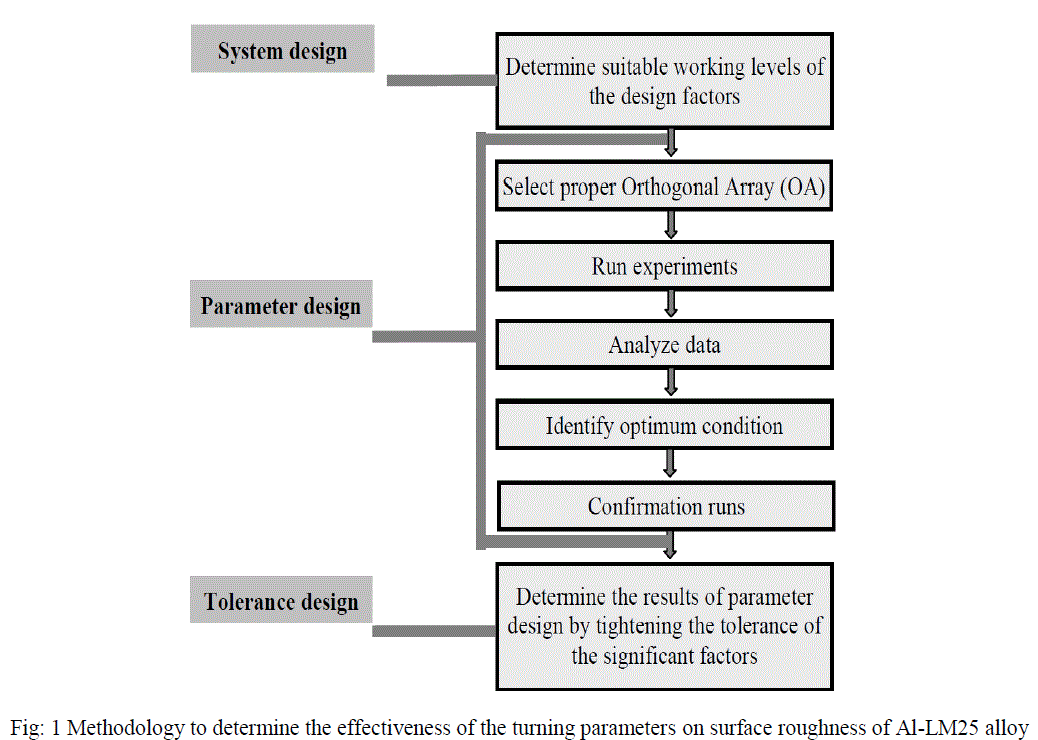 |
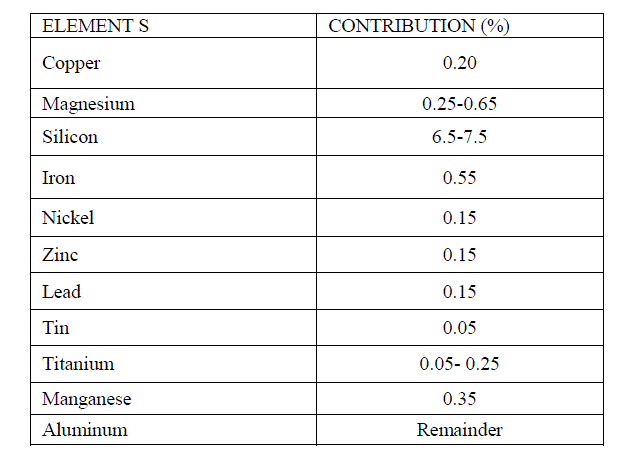 |
V. EXPERIMENTAL WORK AND PROCEDURE |
| Fabrication of metal matrix composite requires very good interfacial bond condition between matrix and reinforcement. In our study aluminium (LM25) material is preheated to 8500c using pre heater furnace. Fig c shows the casting setup used in the experiment, Electric furnace was used to melt LM25. It was heated up to 8000c the material will be melts. Later melt was poured into a die of diameter 30mm and 100mm length. After finishing the material we done turning operation by using CNC Lathe machine. |
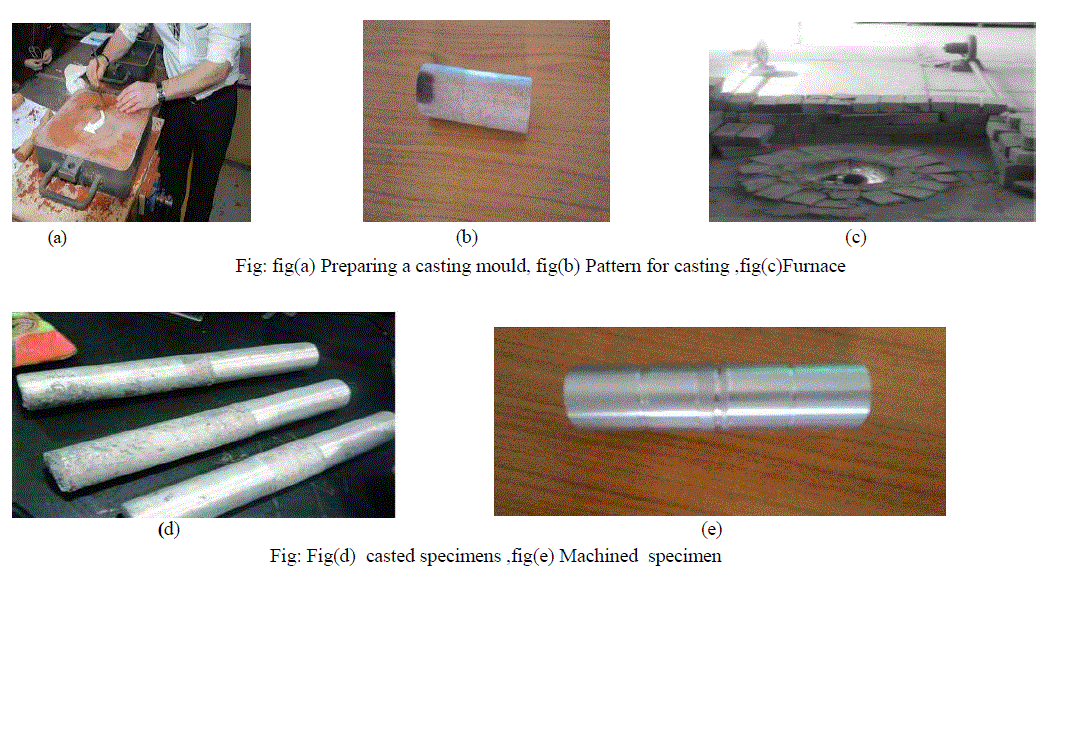 |
4.3 FLEXTURN MTAB CNC LATHE TOOL: |
| FLEXTURN MTAB CNC Lathe tool was available at Madanapalle institute of technologically and science, which was used for experimentation purpose. |
| Specifications of CNC Lathe tool: |
| Specifications of CNC Lathe tool: |
| ï Range of Feed rate up to 5000 mm/min |
| ï Bed type 450 slant bed, length 300mm |
| ï Maximum swinging range of diameter on chuck 80mm |
| ï Chuck size 100mm |
| ï Maximum turning length 195mm |
| ï Power 3phase, 415W, 50Hz |
| ï Extreme shaft power 3.7KW |
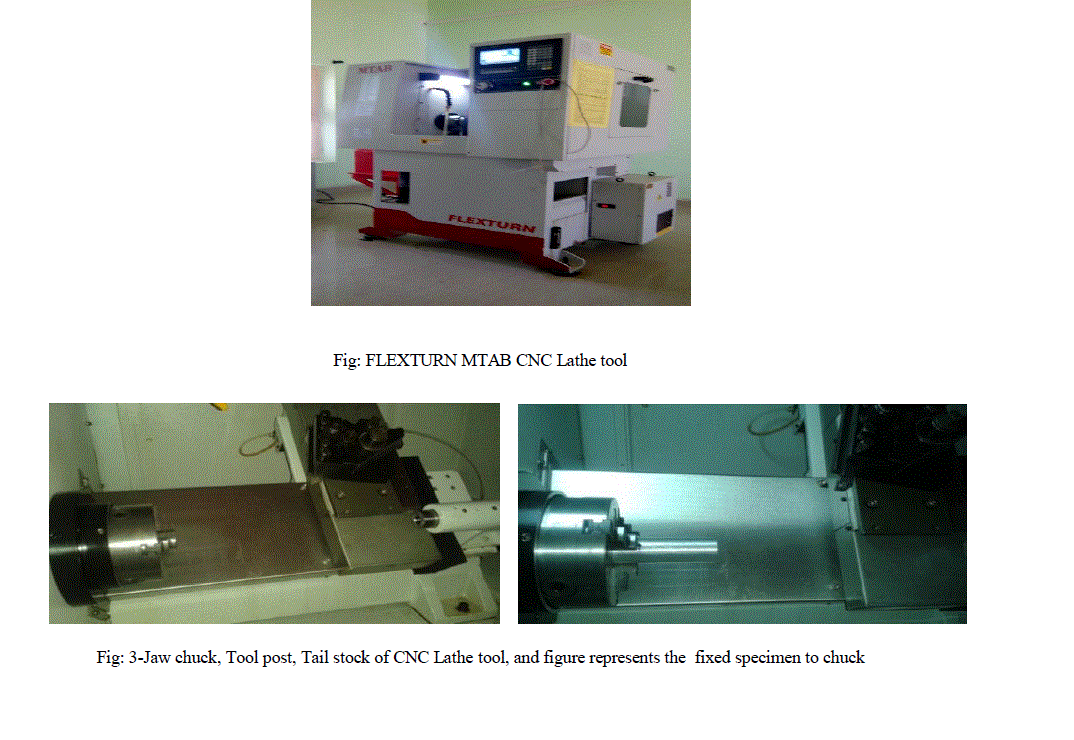 |
5 Types of Tool Inserts According to Coatings: |
| Tool inserts are categorized in to two types |
| A). Coated B). Uncoated |
| The Coated tool inserts are sub divided in to The un coated tool inserts are categorized in to |
| 1.Gradient Monolayer coated 1. Nitride Ceramics-SiC3N4 |
| 2. Two layer coated 2. Cermets’, and |
| 3. Multilayer coated 3. Oxide Ceramics Al2O3 |
 |
| 6.Measuring of surface roughness: By using the MITUTOYO surf tester (SJ-210 model) we can measure surface roughness (Ra), (Rq), (Rz) with cutoff length 0.8mm and transverse length of 5mm. The surface roughness Ravalues average of the absolute value for the heights of roughness irregularities from the mean value measured. The measured surface roughness of each test specimens for every trail run placed below table 1 and 2 respectively. |
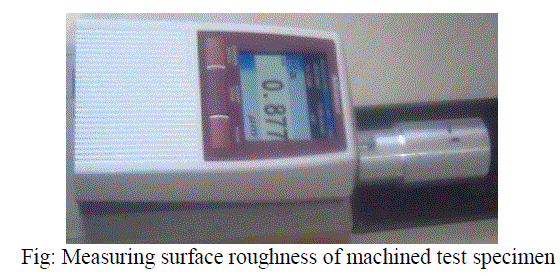 |
7 Material removal rate |
| It is calculated by change in work piece volume to the taken during turning. |
 |
8 Mach inability study |
8.1 Taguchi method |
| Select an experimental design: As per levels and factors quantity the experimental design will be selected, for this project we were selected the L9 array design. This design consists of total quantity of 9 trail runs or tests should be carryout by project. Analysis of DOE data: Numerical approaches will be used in data analysis. 1. Identification of relevant and irrelevant impacts and interfaces or relations. 2. Grade of virtual significance of factor impacts and interfaces or relations. Analysis of variance (ANOVA) can notice the relative meaning of each factor by allocating a numerical value. 3. Empirical mathematical model of response versus experimental factors. The form of the mathematical model could be linear or polynomial, plus interactions. DOE data analysis can also provide graphical presentations of the mathematical relationship between experimental factors and output, in the form of main-effects charts and interaction charts. |
Full factorial design of experiments: |
| A full factorial design may also be called a fully crossed design. |
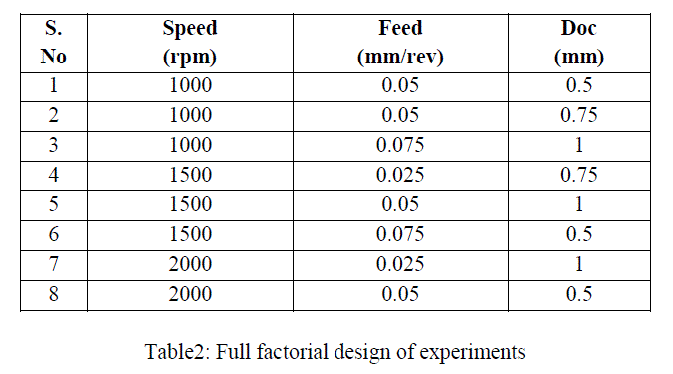 |
8.2 Design of experiments |
| In order to determine optimal cutting parameters from the experimental observations the depth of cut is considered. The experimentation of this paper is to study, orthogonal array has been used to find the effect of the three process parameters. |
 |
| The machining tests were conducted according to the 3 level and 3 factors orthogonal array. The experiments are planned using the taguchi technique .The experiments were conducted at 3 different cutting speeds (1000, 1500, 2000 m/min) with 3 different feed rates (0.025, 0.05, 0.075 mm/rev) and varying cutting depth (0.5, 0.75, 1 mm). The cutting parameters and their levels are indicated in Table 3. |
8.4ANOVA Analysis |
| The recorded experimental results are investigated using analysis of variance (ANOVA) for determining the parameters affecting the performance measures on the total variance of the results. |
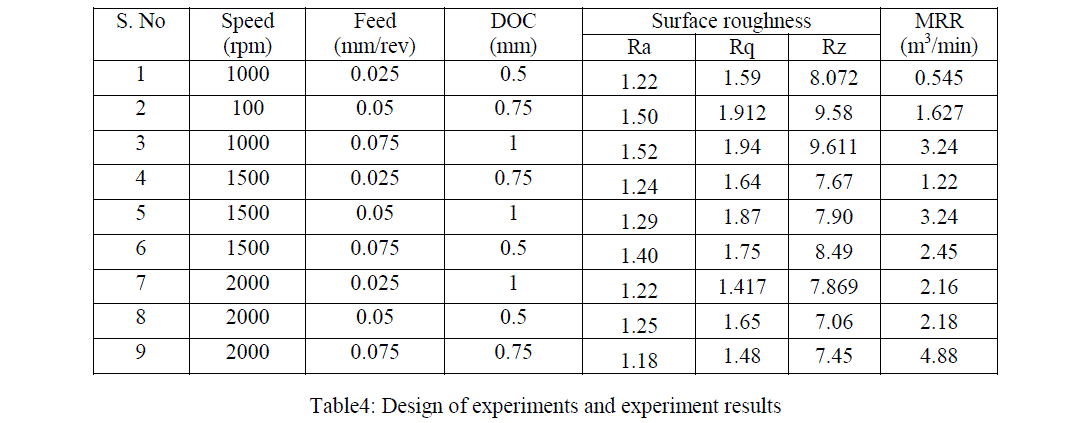 |
8.5 Results and Discussion |
8.5.1 Surface roughness (Ra) Results |
Taguchi Analysis: Surface Roughness versus Speed (rpm), Feed (mm/rev), DOC (mm) |
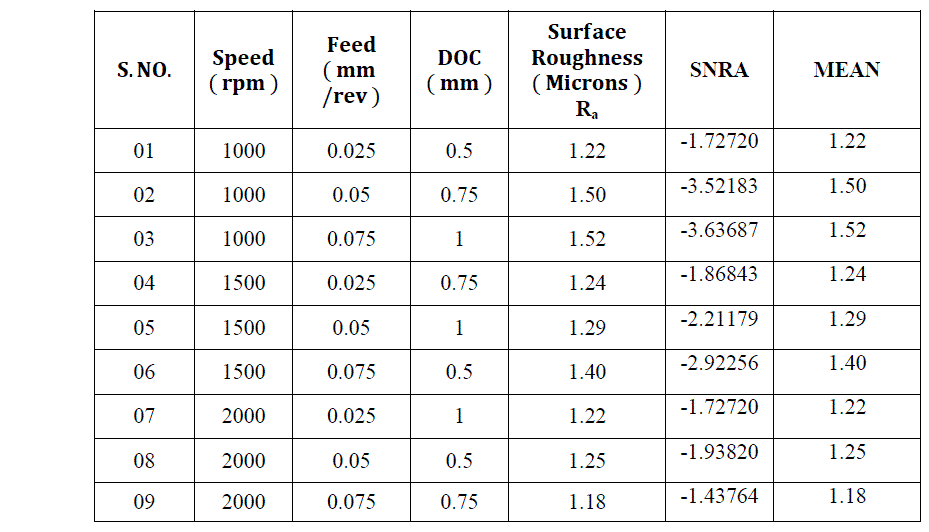 |
| Linear Model Analysis: SN ratios versus Speed (rpm), Feed (mm/rev), DOC (mm) Table 18: Analysis of Variance for SN ratio(R-Sq = 91.9%) |
| S = 1.198 R-Sq = 91.9% R-Sq (adj) = 67.6% |
Linear Model Analysis: Means versus Speed (rpm), Feed (mm/rev), DOC (mm) |
 |
 |
 |
 |
 |
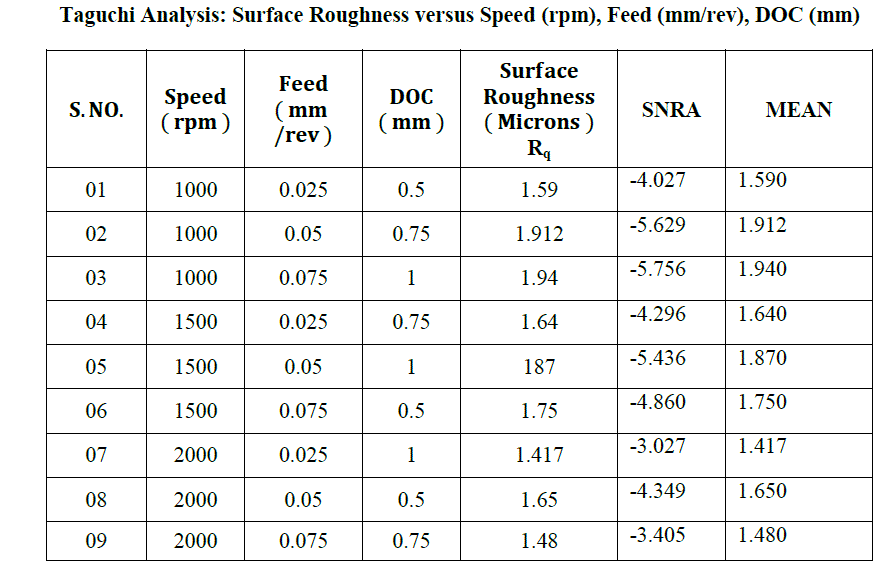 |
 |
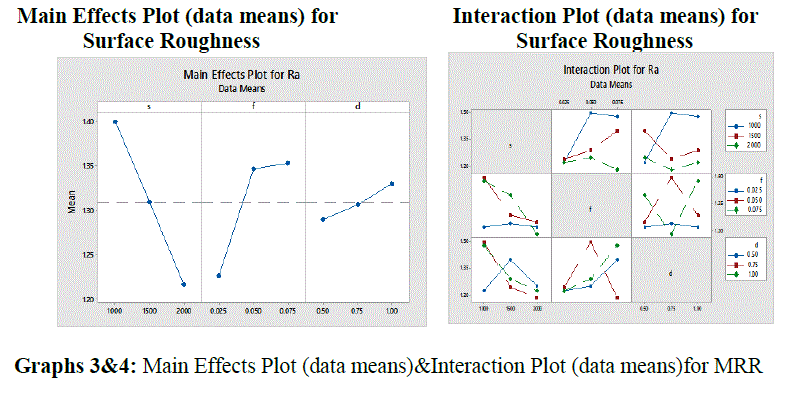 |
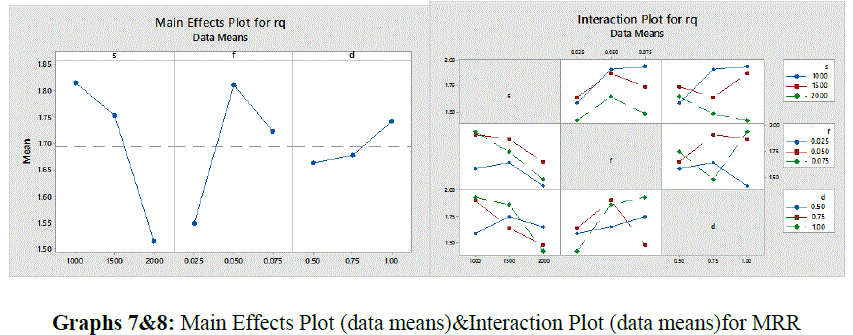 |
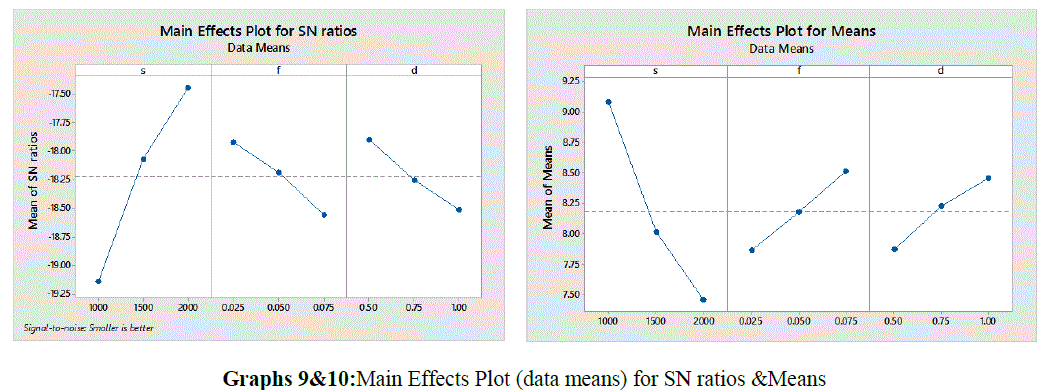 |
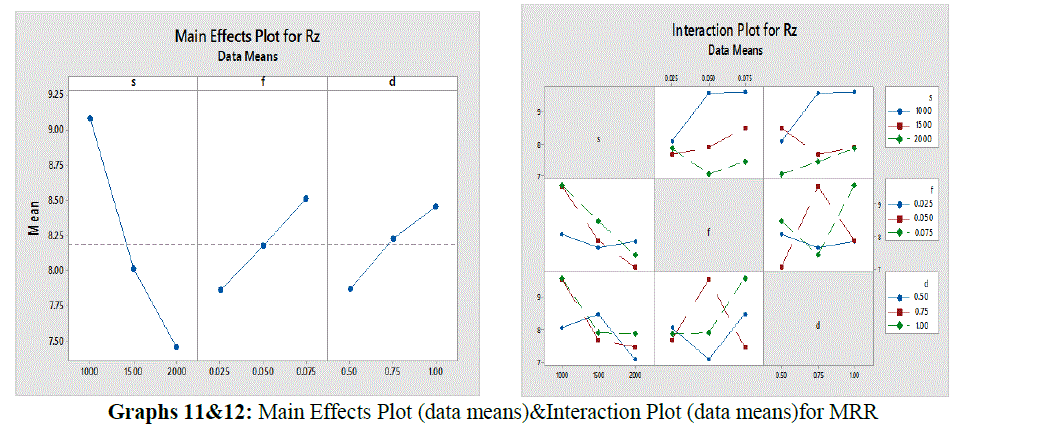 |
 |
 |
Linear Model Analysis: Means versus Speed (rpm), Feed (mm/rev), DOC (mm) |
| Table 19: Analysis of Variance for Means(R-Sq = 92.7%) |
 |
| Table 20: Response Table for Signal to Noise Ratios Smaller is better |
 |
 |
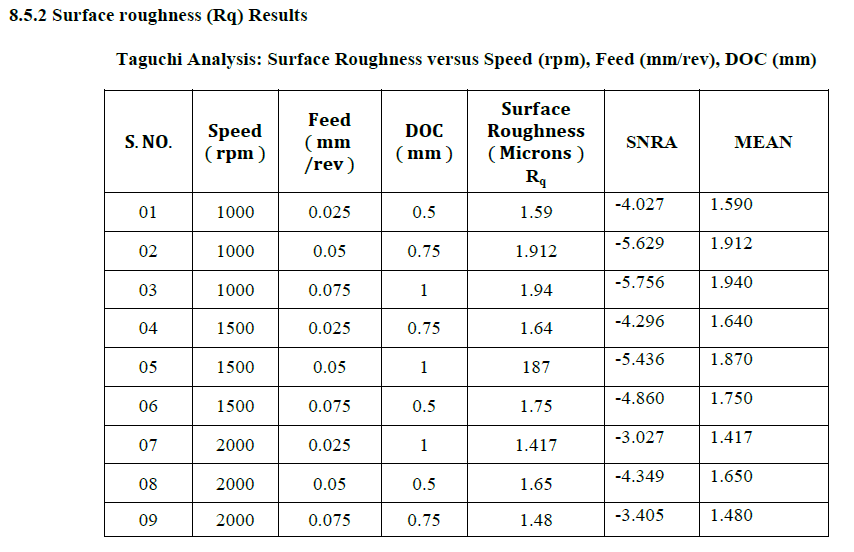 |
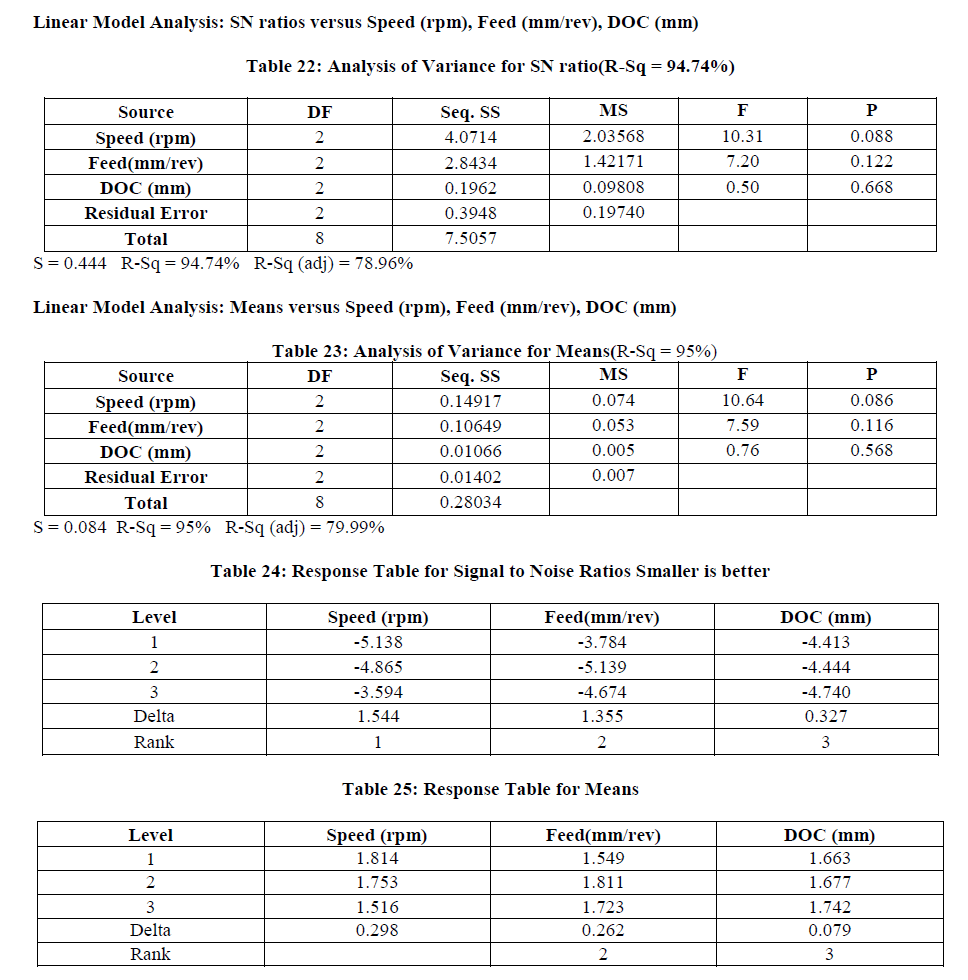 |
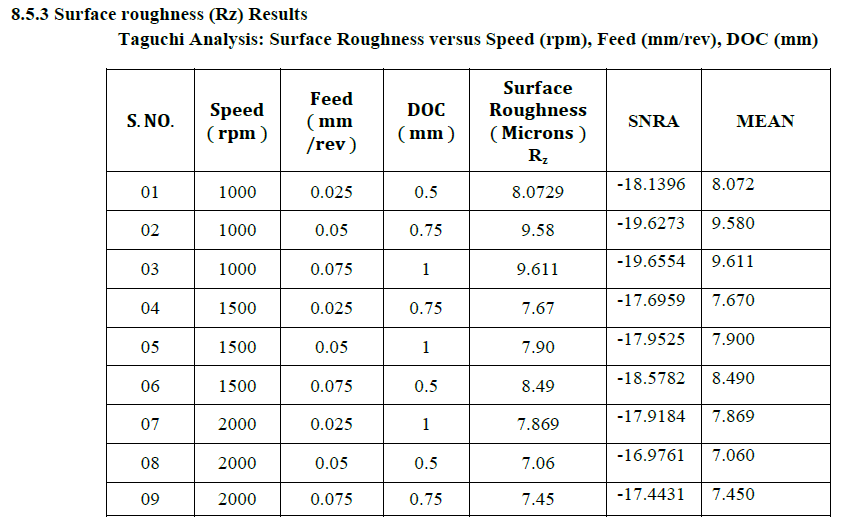 |
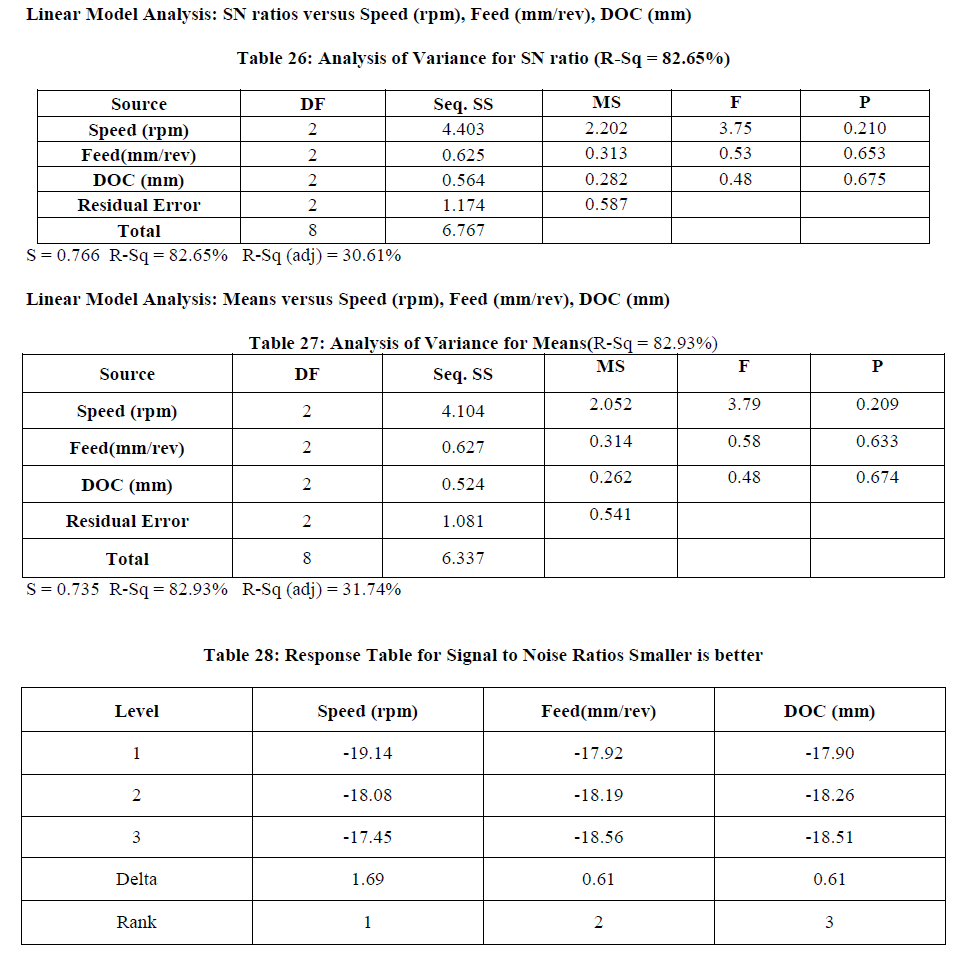 |
 |
VI. CONCLUSION |
| Hence machining is carried out on LM 25 Aluminium alloy and surface roughness values are derived for the specimen the turning operation parameters such as surface roughness, material removal rate are successfully optimized by using design of experiments . |
References |
|